Spiraea is a deciduous shrub that is valued by gardeners and landscape designers for its abundant and long-lasting flowering, resistance to unfavorable growing conditions and ease of care.
Descriptions of shrub varieties with photos and names will help you select such specimens of the crop so that the spirea blooms continuously from spring to late autumn.
Characteristics of spirea varieties in the video:
| Content:
|
What types of spirea are there?
The genus Spiraea belongs to the rose family and has more than 90 species. The height of the bushes ranges from 0.20 m to 2 m. Depending on the type and variety, the appearance of the plant is different: from a low compact bush to a two-meter spreading shrub.
The stems can be straight, spreading or creeping, the flowers are small but numerous. The shades of the petals are white, cream, pink, crimson. The foliage is decorative throughout the season and varies in color and shape.
According to the timing of flowering, spirea is divided into two groups:
- spring-flowering - their petals are usually white in color.
- summer-flowering - the color of the petals is pink, red, crimson.
Possessing a wide variety in the shape and size of bushes, the time and duration of flowering, the color of flowers and the shape of inflorescences, shrubs are widely used in ornamental gardening, forest landscaping and the organization of hedges. Spiraea are also used as soil-building plants; in addition, they are honey plants and medicinal plants.
Frost-resistant spirea varieties for the Moscow region
All types of spirea are frost-resistant to varying degrees.In central Russia, preference is given to spring-flowering varieties that are characterized by increased frost resistance. When growing summer-flowering varieties, measures are taken to protect plants from frost.
Video: how to properly create beautiful compositions from ornamental shrubs:
Tall varieties for the Moscow region
Spiraea middle (S. media)
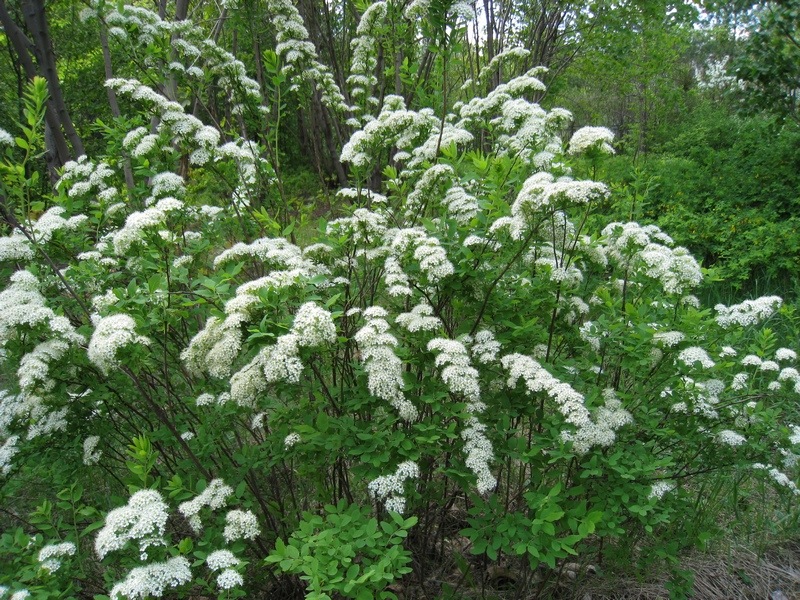
S. media
Spiraea oakleaf (S. chamaediyfolia)
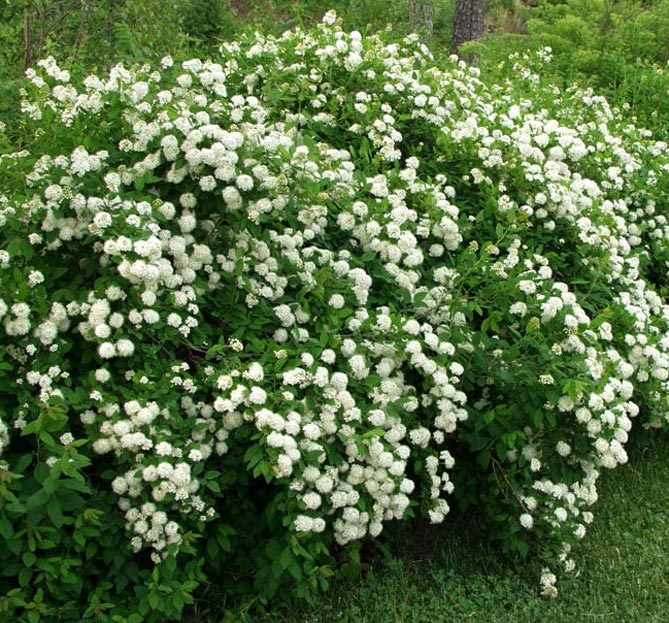
S. chamaediifolia
- The height of the bush is 2 m. The crown is dense, rounded, the leaves are similar to oak. In autumn the foliage turns yellow.
- Flowering lasts from late May to mid-June for 20-25 days.
- Tolerates slight shade. Prefers moist soils.
- It is a frost-resistant species and is therefore actively cultivated in temperate latitudes.
- It is used in landscaping gardening areas, used for organizing hedges and as a honey plant.
Spiraea Vanhouttei (S. x vanhouttei)
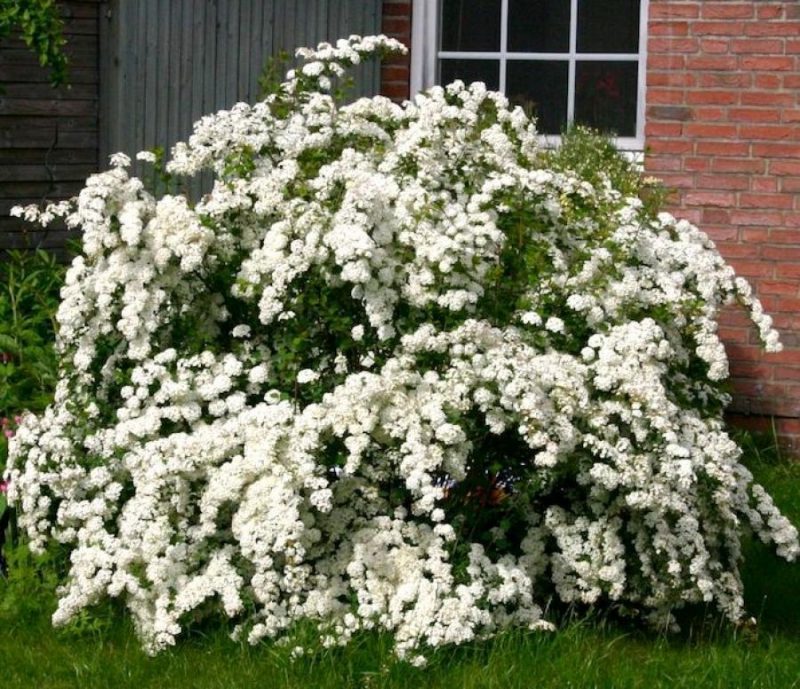
S. x vanhouttei
- A fast-growing hybrid up to 2.2 m high. The arched shoots are densely covered with large white inflorescences (7 cm).
- Blooms from mid-June to early July. In favorable conditions, it blooms a second time in July - August, but less abundantly.
- Frost resistance is high. Suitable for central Russia, in particular for the Moscow region.
- The varieties and forms of this species are spectacular in solo planting on the lawn, in groups with coniferous trees, in hedges, and look original on the banks of ponds and streams.
Spiraea gray Grefsheim (S. Grefsheim)
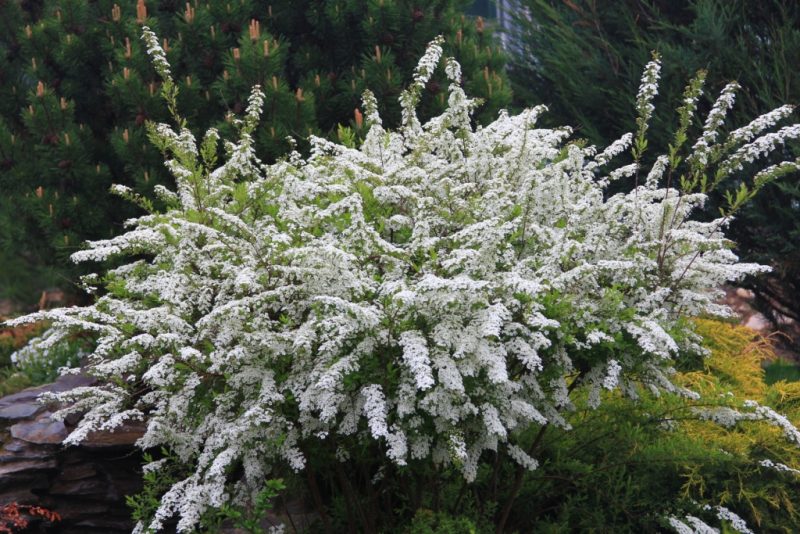
Grefsheim S.Grefsheim
- A fast-growing bush with green foliage, up to 2 m in height and width. The inflorescences are covered with arched shoots along the entire length.
- It is distinguished by fragrant double flowers. Flowering is early (May-June), long and abundant. Can grow in shade.
- Winter hardiness is high; in severe frosts, the tops of young shoots freeze, which affects flowering, but does not lead to the death of the plant.
- Universal use, good honey plant.
Don't forget to read:
Spiraea arguta (S. x arguta) or Spiraea sharp-toothed
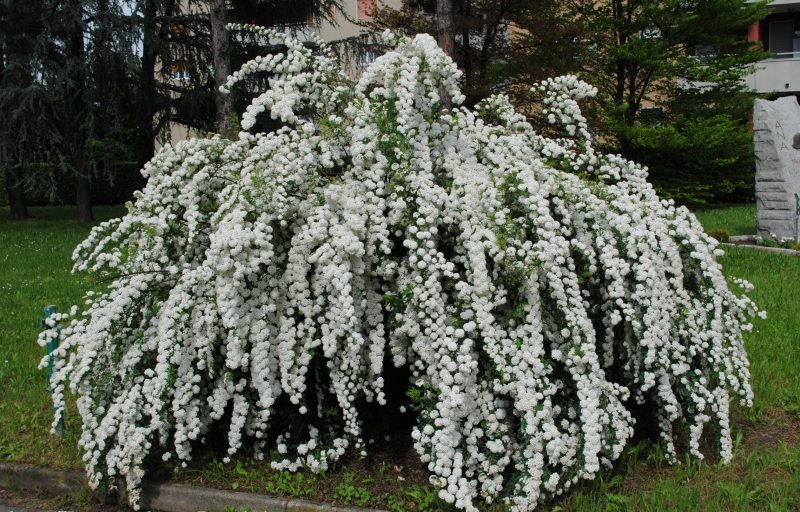
S. x arguta sharp-toothed
- A fast-growing hybrid up to 2 m high with spreading branches forming a spherical crown.
- Flowering is annual, abundant, lasts 3 weeks.
- Photophilous, drought-resistant, adapted to urban conditions. It develops well south of St. Petersburg, in the southern part of the Far East.
- Spiraea arguta is good when planted alone, in plant compositions with other ornamental shrubs, or as a hedge.
In addition to growing in open ground, this species is used for early forcing. On shoots cut in early March and placed in water, inflorescences form in 8-10 days.
Billard's spirea (S. x billardii)
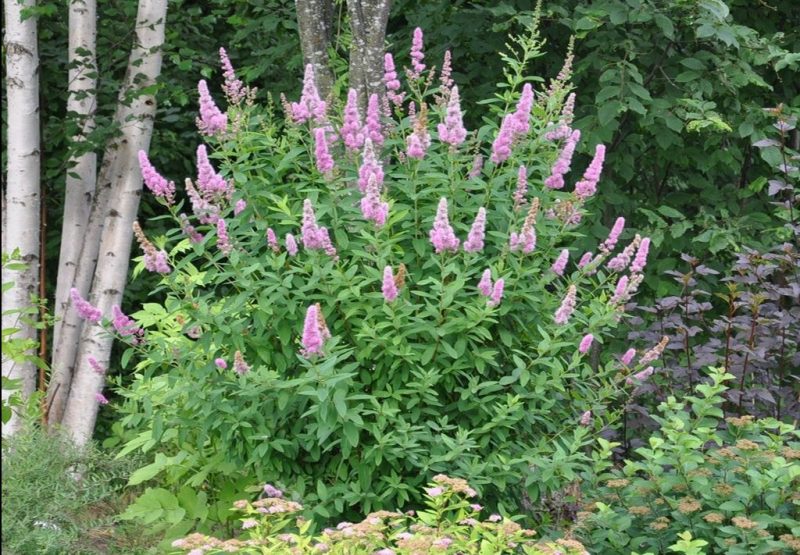
S. x billardii
- Hybrid 2 m high with spreading branches.
- Inflorescences are pyramidal pink. Blooms from late July until frost. Tolerates light shade, but blooms much more abundantly in full sun.
- Frost-resistant, widespread as an ornamental crop from Arkhangelsk to the Caucasus.
- Used to create green hedges and plant compositions.
Spiraea tomentosa (S. tomentosa)
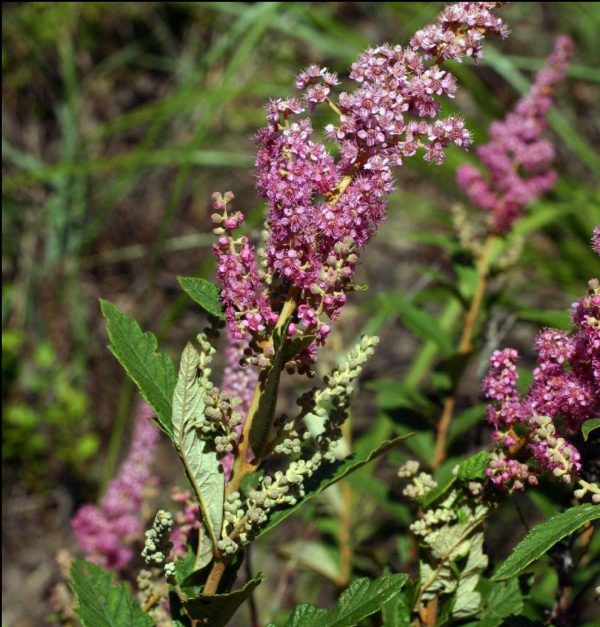
S. tomentosa
- Shrub up to 1.5 m tall, with large, narrow pyramidal inflorescences.
- Flowering is long - from July to mid-September. Petals are pink-violet.
- Prefers to grow on moist soils, in well-lit places.
- Frost-resistant plant, but in severe winters, annual shoots freeze.
- Universal use - for gardening, for zoning as a hedge.
Spiraea (S. salicifoiia)
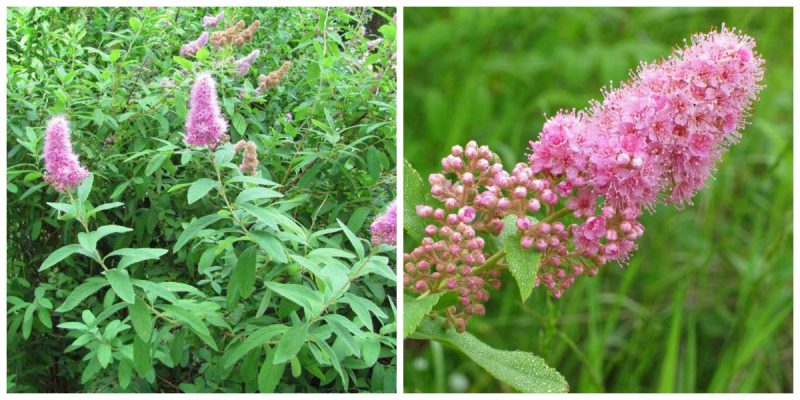
S. salicifoii
- Plant height up to 2 m.
- It blooms with white and pink pyramidal inflorescences in June-August.
- It produces a lot of root shoots, so it grows quickly. Loves moist soils.
- Frost-resistant, can be grown in the northern regions of the country.
- Universal use.
Low-growing winter-hardy varieties for the Moscow region
Low-growing plant varieties and forms are highly decorative. The description and photo will help you choose the most suitable variety for landscaping your garden plot. In addition, low-growing varieties are easier to prepare for winter.
Spiraea Thunbergii (S. thunbergii)
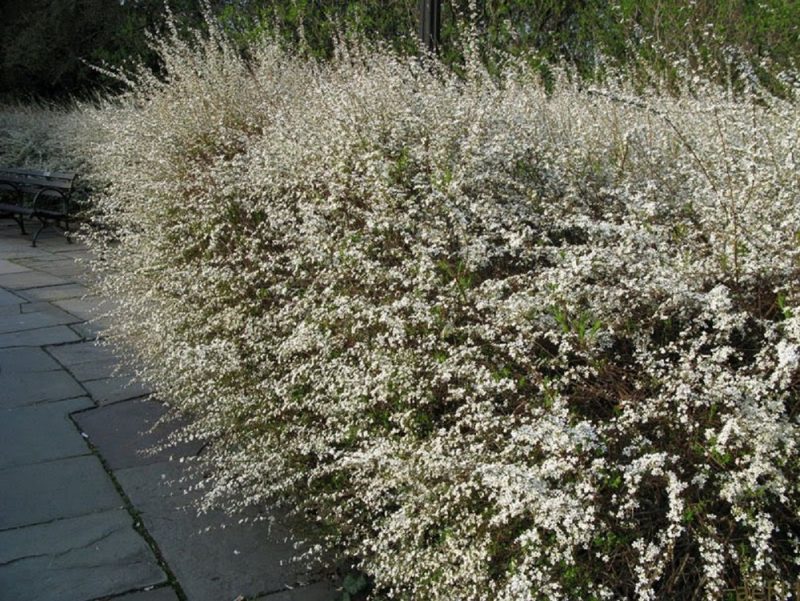
S. thunbergii
- In the Moscow region it grows up to 1.2 meters.
- In autumn the leaves turn orange. Flowering continues from late May to mid-June.
- The plant is drought-resistant. Prefers sunny places.
- In the middle zone it can freeze slightly in severe winters and requires shelter.
Nippon spirea (S. nipponica)
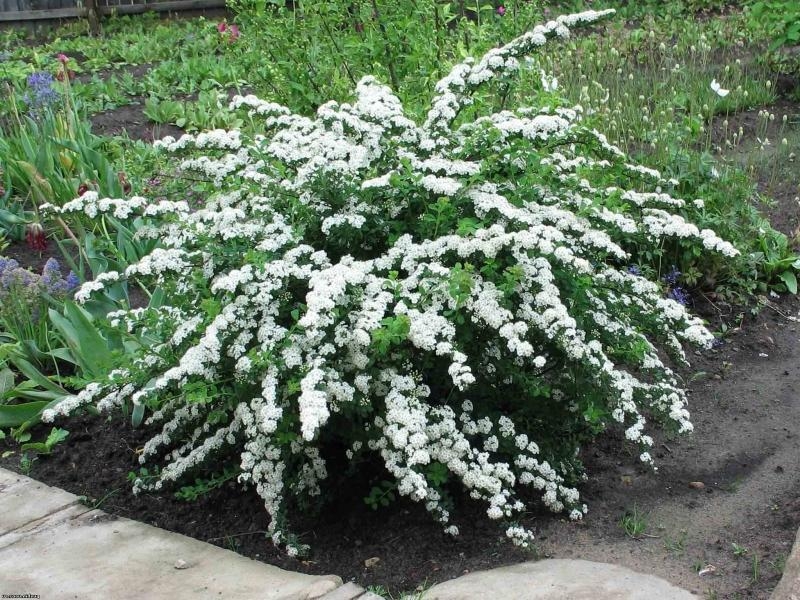
S. nipponica
- Plant height 1 m, width 1 m. It has a spherical crown with horizontal branches.
- It blooms profusely with cream flowers in early June for 15-25 days. The leaves remain green until the end of the growing season.
- Winter hardiness is high. Light-loving, but can also grow in partial shade. Prefers well-drained and moist soils.
- Used for planting on alpine hills and rock gardens, to create hedges, and in urban landscaping. Can be grown in a container.
Varieties that deserve special attention:
Spiraea Nipponum Halvard Silver (S. Halward’s Silver)
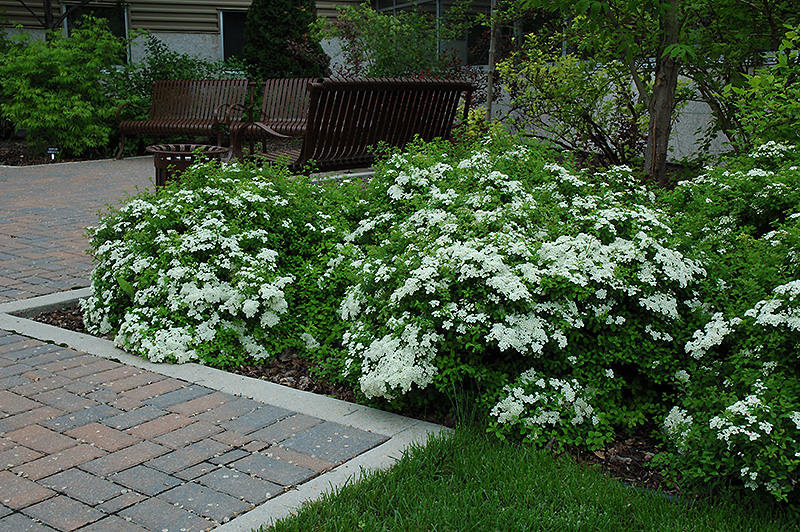
Halvard Silver
- The bush is up to 1 m high, up to 1.2 m wide.
- The inflorescences bloom in June. The advantage of the plant is that it blooms again in the fall.
- It is a winter-hardy variety, but in severe winters the ends of the shoots freeze.
Spiraea nippon Gerlves Rainbow (S. Gerlves Rainbow)
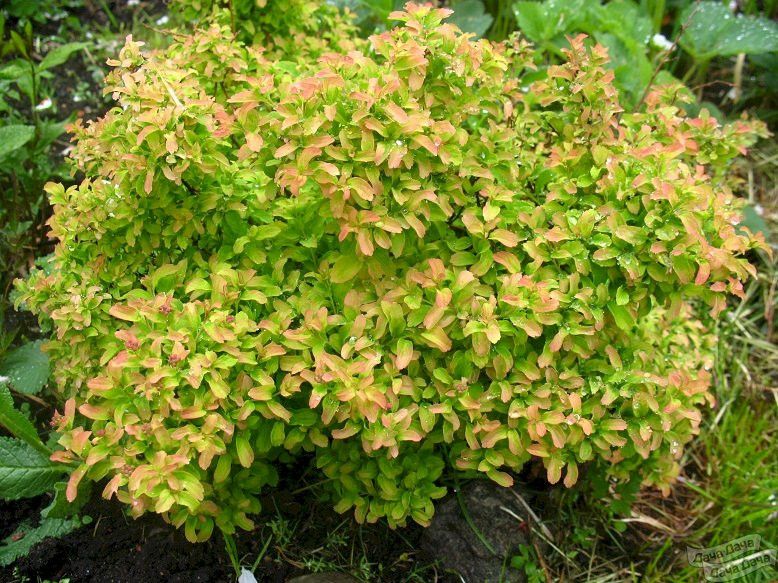
Spireya nipponskaya Halvard Sil'ver
- Compact (0.6 m), spherical shrub with yellow-green leaves.
- Depending on the season, one of the shades predominates to a greater extent.
- Blooms profusely in late May - early June, with white flowers.
Spiraea nippon June Bride (S. June Bride)
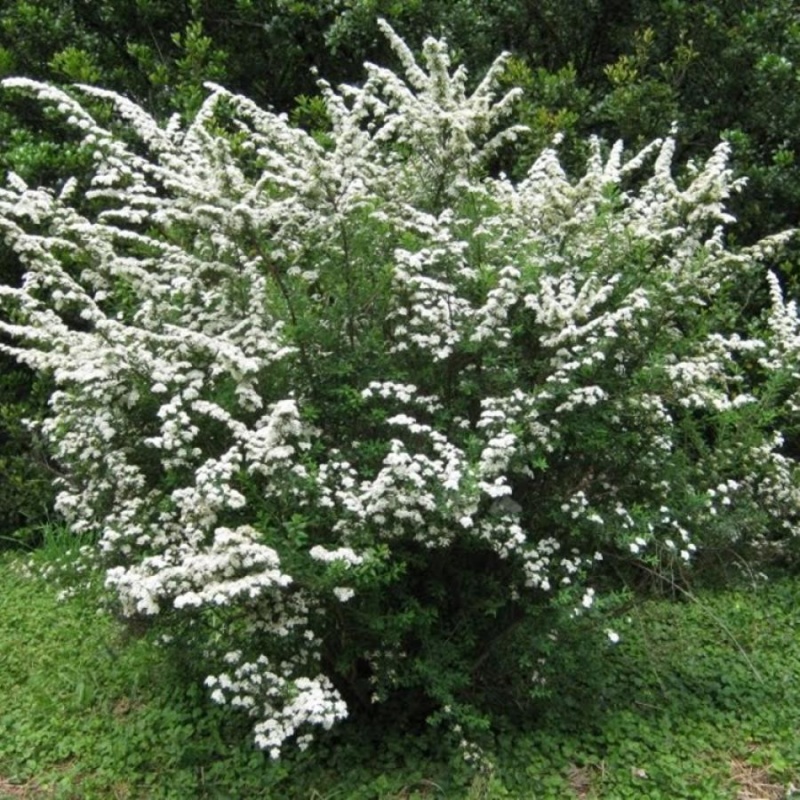
Dzhun Brajd
- Spreading bush up to 1-1.2 m high.
- The flowers are snow-white and bloom profusely in May-June. After pruning it recovers quickly.
- The shrub grows safely in urban environments.
- Winter-hardy, does not freeze at temperatures down to -29°C.
Birch leaf spirea (S. betulifolia)
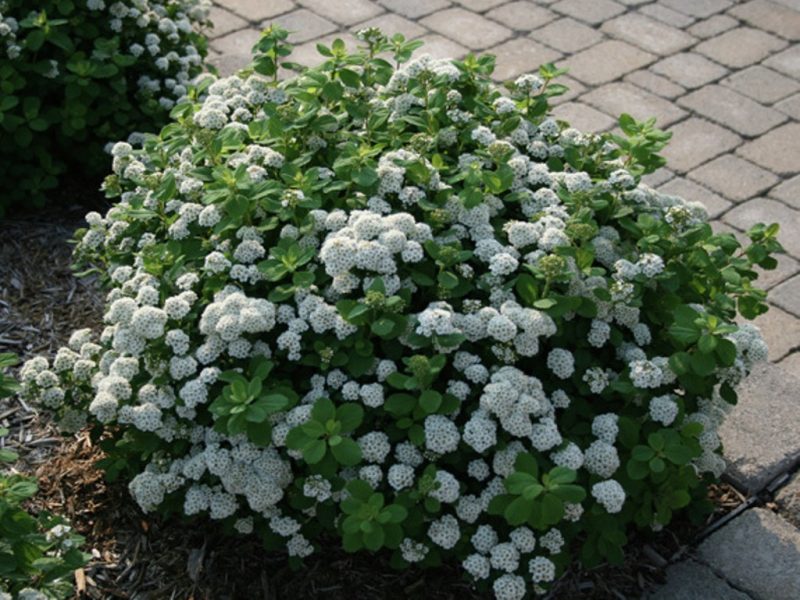
S. betulifolia
- A low (0.5-0.8 m) bush with a dense, ball-shaped crown and ribbed, sometimes zigzag-curved shoots. Externally, the leaves of this hybrid resemble birch trees; in autumn the color of the leaves is bright yellow.
- It blooms with white and pink inflorescences from the second half of June for 2 weeks.
- Prefers moist soils. Frost-resistant species, overwinters without shelter.
- Used for trimming tall trees and shrubs on alpine hills.
Spiraea Bumalda (S. x bumalda)
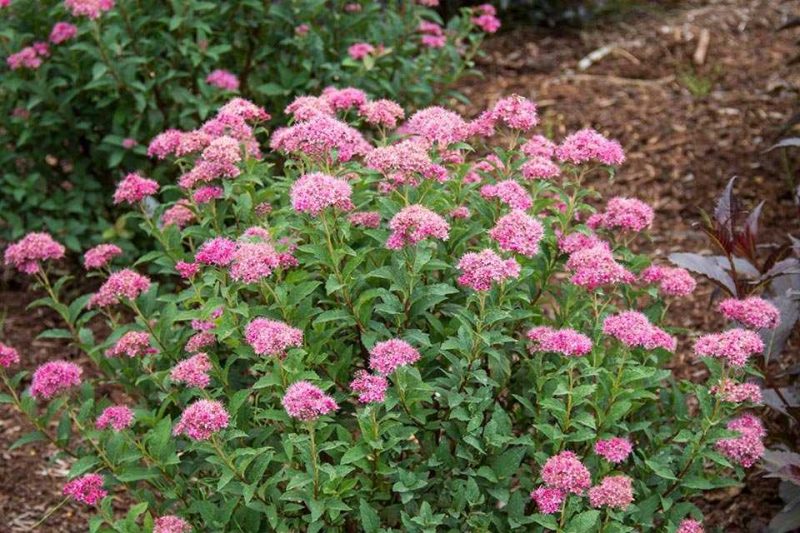
S. x bumalda
- Hybrid 0.75 m high, with straight branches and a spherical crown.
- The color of pink flowers can vary from light to dark. The leaves are purple in spring, dark green in summer, and turn red in fall.
- The plant blooms in June-August, about 50 days.
- Frost resistance is high.
Varieties of Japanese spirea
The bushes grow slowly.Prefers to grow in sun or shade during midday hours. Widely used all the way to the Arctic Circle. It blooms in the summer months with pink-red flowers for about 45 days. Used when arranging low hedges and borders. The shrub looks great on alpine hills, in rocky gardens, as well as in the foreground of coniferous plantings.
Japanese spirea has many decorative varieties and forms, which differ in the size of the bush and leaves, and the shade of flowers:
Darts Red (S. japonica Dart`s Red)
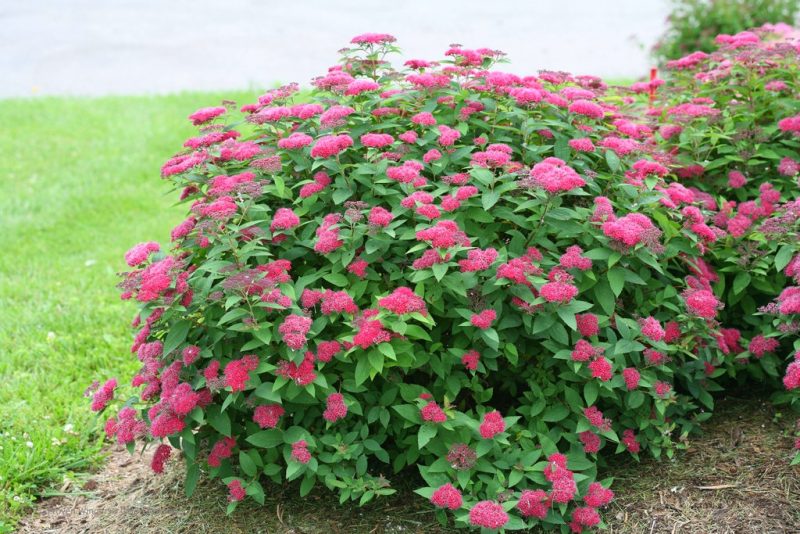
S. japonica Dart`s Red
- Bush 0.6 - 0.8 m high.
- Characterized by changes in foliage color over the course of the season from pink and dark green to red.
- Flowering continues from July for 50 days with bright crimson flowers.
Little Princess (S. japonica Little Princess)
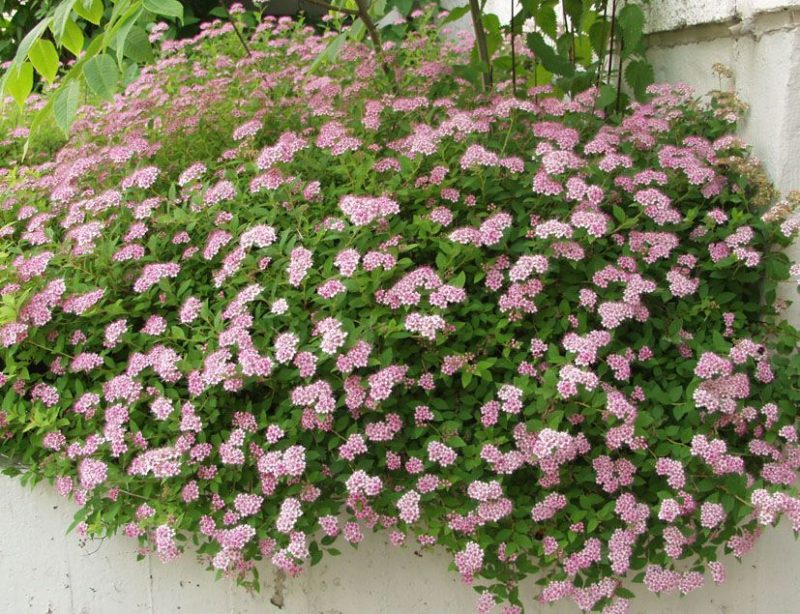
S. japonica Little Princess
- Bush 0.6 m high. The crown is spherical, compact.
- Blooms with pink flowers in June-July.
- Winter-hardy. In the middle zone it winters well and is relatively drought-resistant.
Shirobana (S. japonica Shirobana)
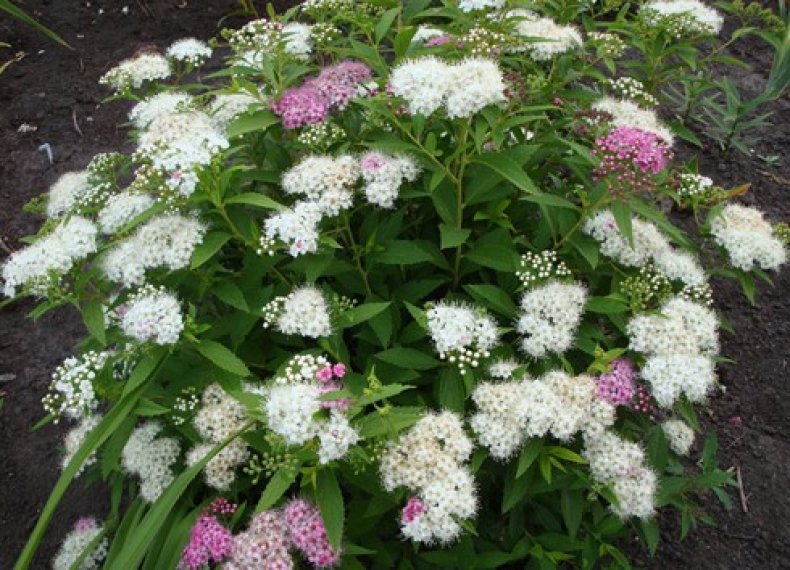
S. japonica Shirobana
- Bush 0.8 m high.
- The color of the flowers varies from pale white to pink or red. Flowering lasts from July to August.
Firelight (S. japonica Firelight)
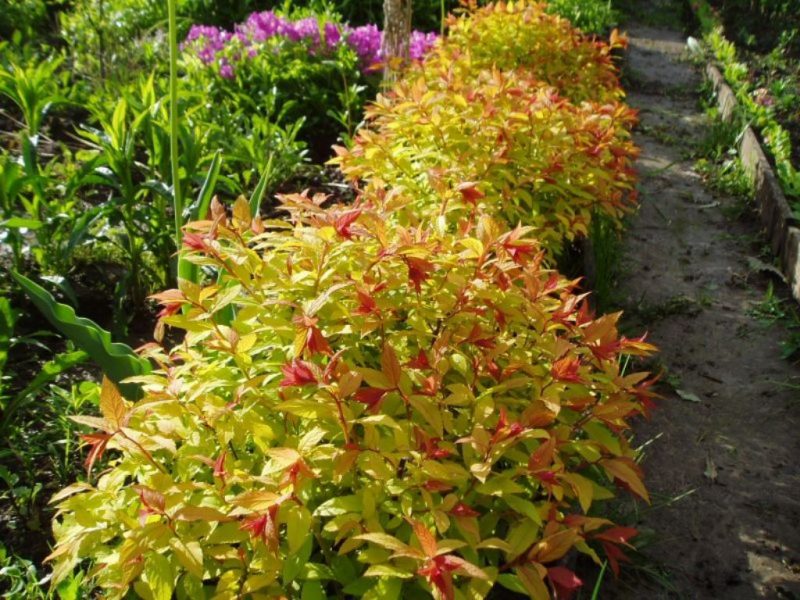
S. japonica Firelight
- Slow-growing shrub up to 0.6 m high and up to 0.8 m in diameter.
- The foliage is orange when blooming, greenish-yellow during flowering, and red in late summer and fall.
- Flowers of dark pink shades. It blooms in June-July, often blooming again in August.
- In the central zone, in the Moscow region, it winters without shelter.
Macrophylla (S. japonica Macrophylla)
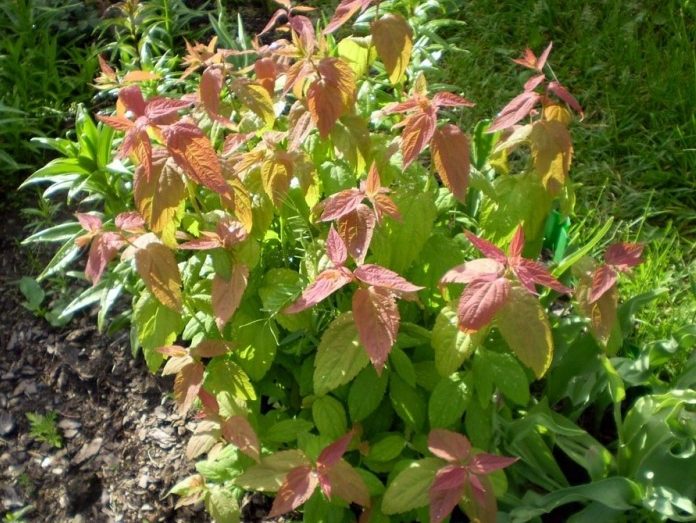
S. japonica Macrophylla
- Bush 1.3 m high.
- It is characterized by large, wrinkled leaves that are red when opening, then green, and yellow in the fall.
- Flowering continues from the end of July for 30 days.
Goldflame (S. japonica Goldflame)
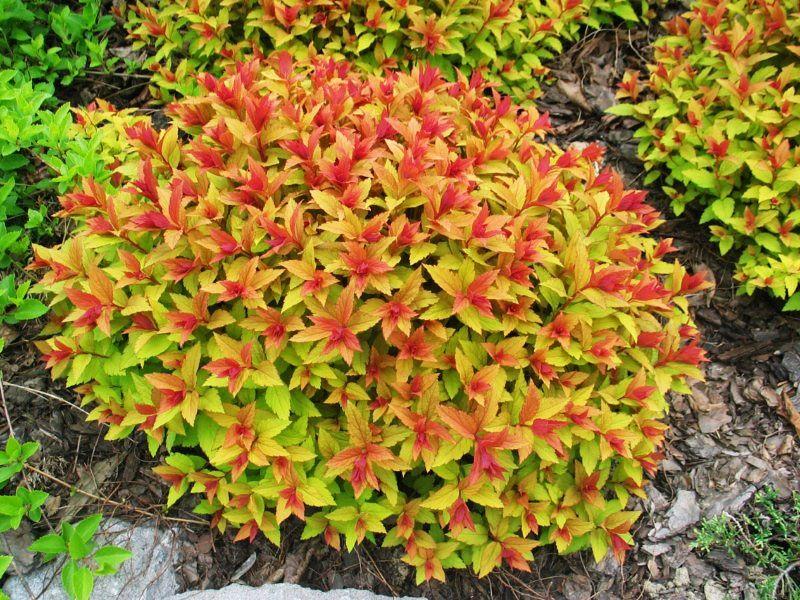
S.japonica Goldflame
- Dense shrub 1 m high.
- The leaves change color throughout the season from orange-yellow to yellow-green. The flowers are pink-red.
- In harsh winters in the Moscow region, the upper part may freeze, but the plants quickly recover and bloom well.
Don't forget to read:
Golden Princess (S. japonica Golden Princess)
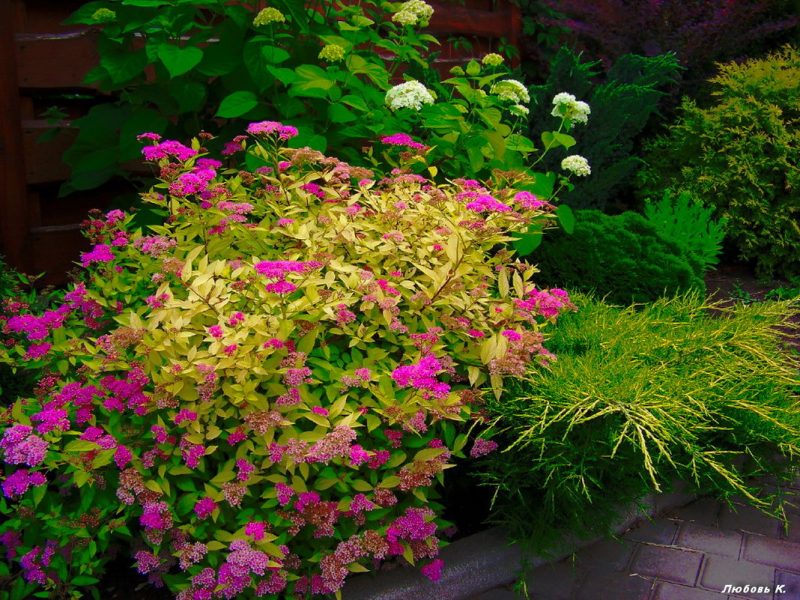
S. japonica Golden Princess
- Shrub 1 m high, with yellow leaves throughout the season. Flower color is pink.
- In the Moscow region and St. Petersburg it winters without shelter.
Tall varieties for the southern regions
In the southern regions, all varieties and varieties can be planted without restrictions. In this case, no special measures to prepare for winter will be required.
Spiraea plum leaf (S. prunifolia)
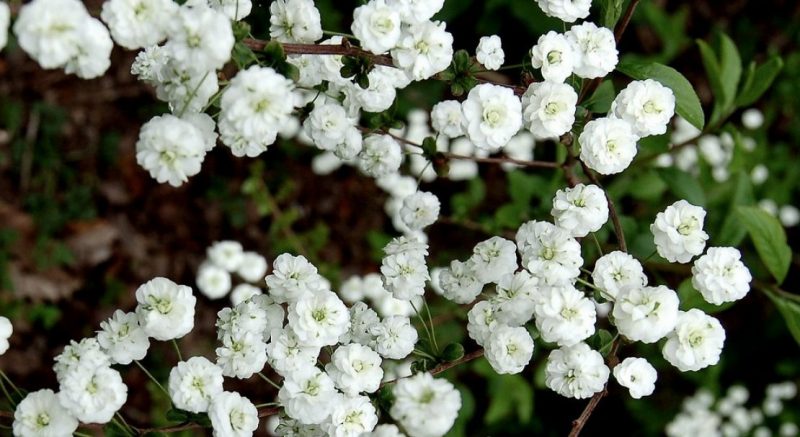
S. prunifolia
- Bush up to 2 m tall, with thin, flexible shoots.
- The autumn color of the leaf blades is orange-brown. It does not bloom every year in May-June with white double flowers. Drought resistant.
- Frost resistance is average; at sub-zero temperatures, not only young but also adult shoots suffer. A place for this species must be chosen that is protected from northern winds.
Douglas spirea (S. douglasii)
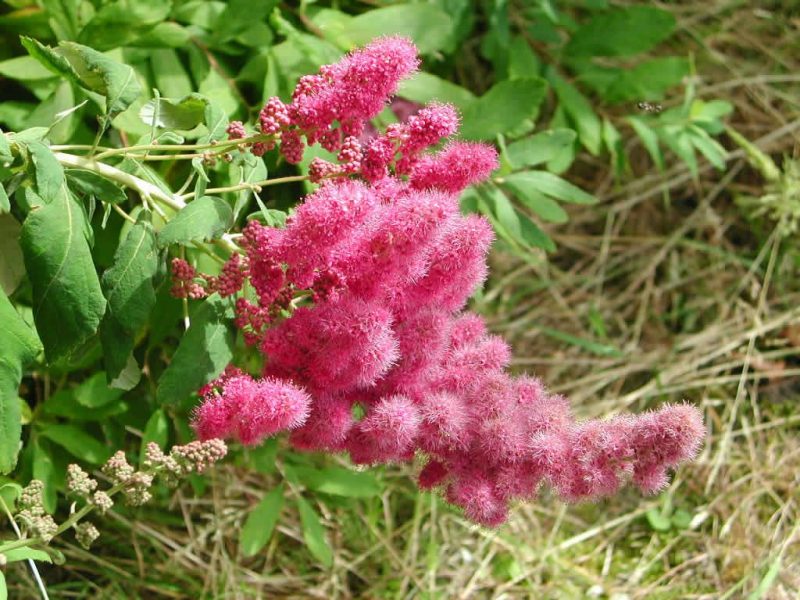
S. douglasii
- Bush up to 1.5 m high.
- The inflorescences are dark pink, pyramidal in shape, directed upward. They bloom in July for 45 days.
- Often planted in parks, children's and school playgrounds.
Cantonese spirea (S. cantoniensis Lour)
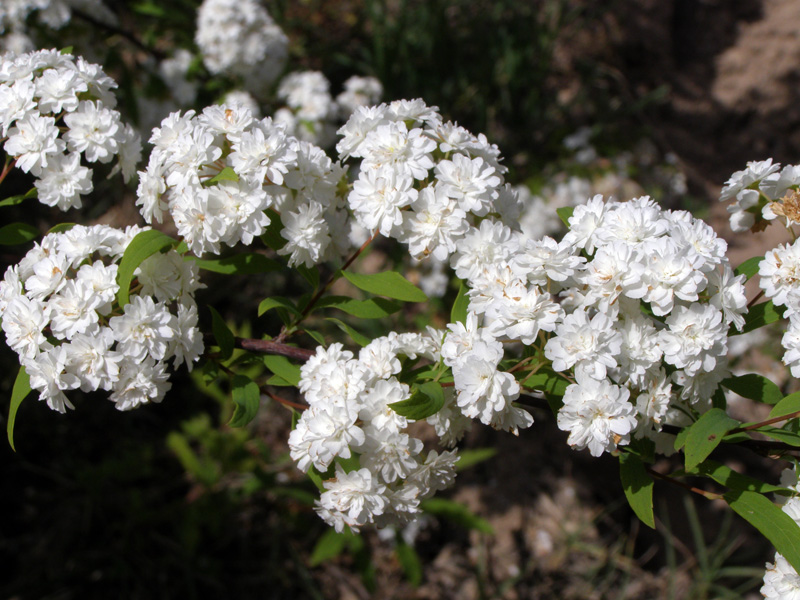
S. cantoniensis Lour
- A fast-growing bush up to 1.5 m high with flexible shoots.
- Drought-resistant, thermophilic. Blooms in late June - early July for 25 days.
- Widely used in decorative landscaping in the southern regions.
- In the Moscow region, shoots are damaged by frost.It is important to find a place protected from cold winds or provide shelter.
In addition to being used in gardening, it is used to create bouquets.
Low-growing varieties for the south
Spiraea bella Sims
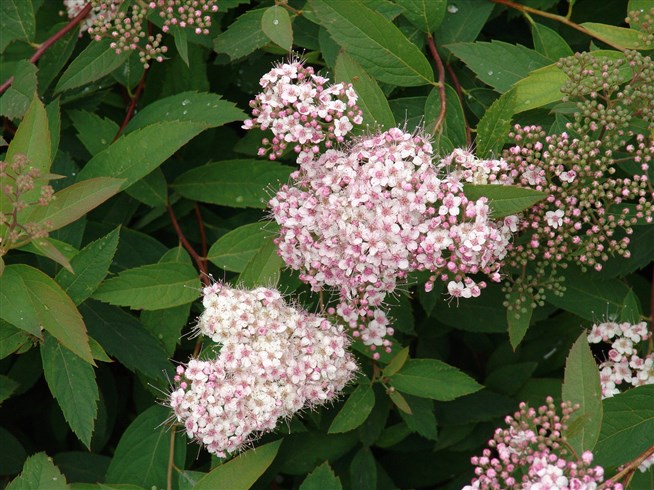
Spiraea bella Sims
- Shrub up to 0.75 m high. Shoots are thin, spreading, red-brown.
- During the growing season it blooms several times, and profusely: in May, then in July, and in August. The flowers are pale pink.
- Winter hardiness is average.
- Irreplaceable in borders and solo plantings on the lawn.
White-flowered spirea (S. albiflora)
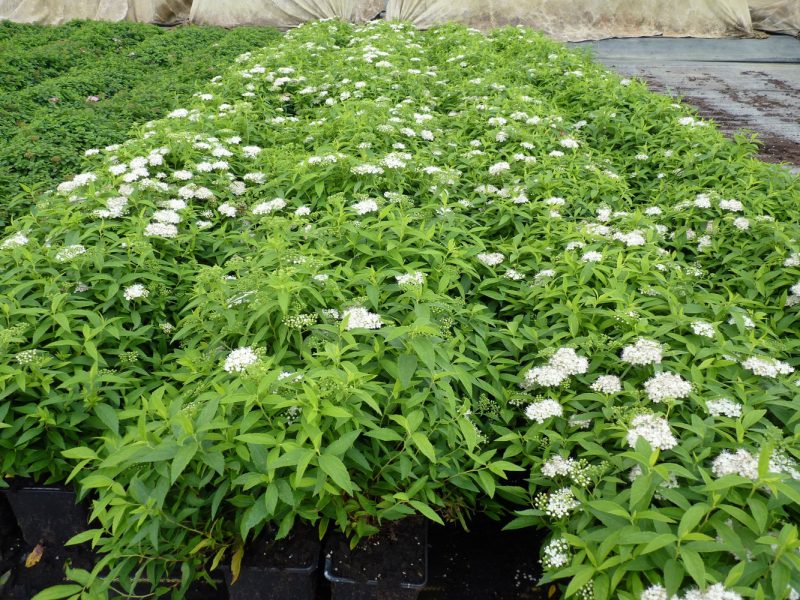
S. albiflora
- Bush 0.5-0.8 m high, with strong, erect branches.
- Blooms profusely with white fragrant flowers from mid-July to September.
- Demanding on moisture and soil fertility. Winter hardiness is below average.
- It is used in organizing recreation areas, borders and lawns.
Dwarf varieties of spirea
Spiraea dwarf (S. x pumilionum Zabel)
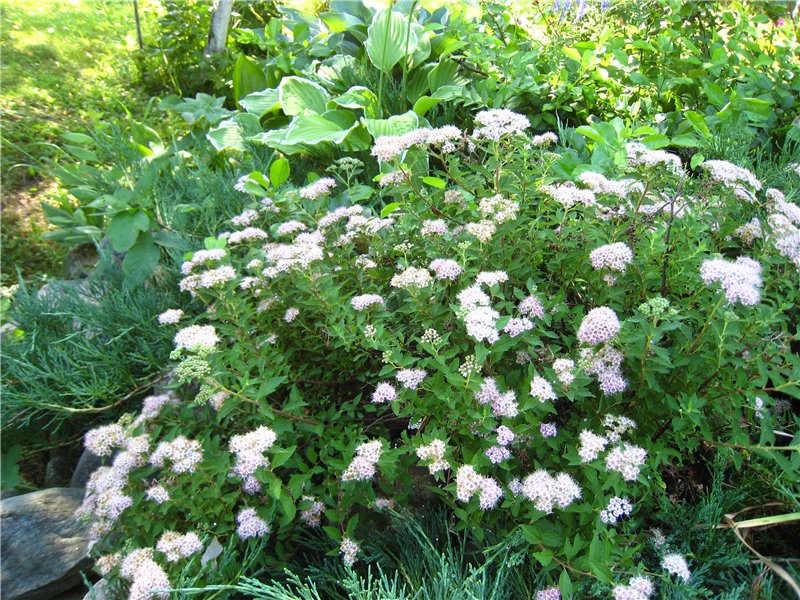
S. x pumilionum Zabel
- Low-growing hybrid (up to 0.2-0.3 m) with creeping shoots.
- It blooms with white, small flowers annually from the second half of June to mid-August.
- Frost resistance is low.
- In landscape design it is used for borders, alpine slides, rockeries.
Spiraea creeping (S. decumbens)
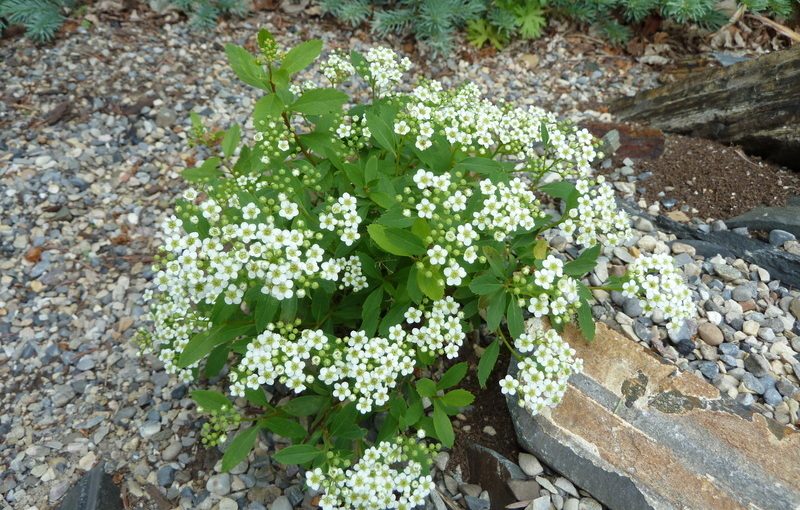
S. decumbens
- Bush 0.3 m high.
- White inflorescences appear from mid-June to August.
- Winter hardiness is average.
Spiraea Nipponica Gelspir (S. nipponica Gelspir)
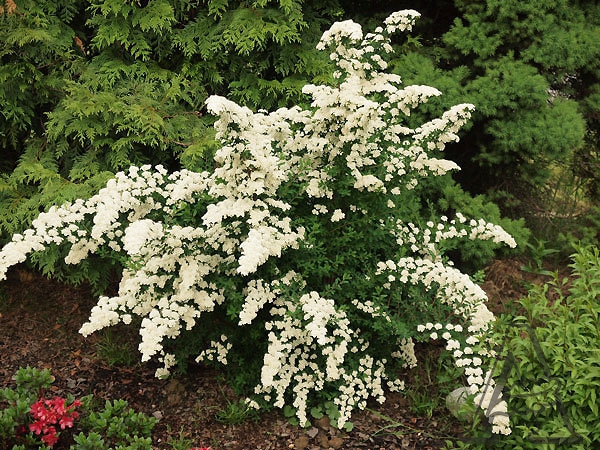
S. nipponica Gelspir
- Dwarf variety (up to 0.5 m). It has a round shape with arched shoots.
- It tolerates shearing well, responds positively to various feedings and fertilizers, and tolerates mild drought well.
- In winter, it is recommended to protect the bush from severe frosts and winds.
Spiraea japonica Gold Mound

Gold Mound
- Dwarf variety 0.5-0.6 m high.
- The foliage is bright yellow.Blooms pink flowers profusely from June to August.
- In harsh winters in the Moscow region, the upper part may freeze, but the plants quickly recover and bloom well.
Varieties for hedges
Spiraea is great for creating hedges. This is facilitated by such qualities of the crop as unpretentiousness, rapid growth after cutting and crown density.
The following varieties are suitable for forming a hedge:
- white
- Douglas
- oakleaf
- Wangutta
- gray
- loosestrife
- Billard
- arguta
- plumifolia.
Growing and care
Spiraea is undemanding to soil and light-loving. The crop is drought-resistant, so it does not require additional watering. It also does well in light shade, but blooms more profusely in the sun. Spiraea Vangutta and middle are more shade-tolerant. The plant is frost-resistant. But in harsh winters it is better to use the following protective measures:
- bend the shoots to the ground
- cover the tree trunk with fallen leaves
- in extreme cases, wrap the bush with non-woven material
- cover wintering bushes with snow
In the spring, varieties are planted that bloom in the spring; in the fall, varieties are planted that bloom in summer and autumn. Varieties that bloom in spring and early summer are pruned immediately after flowering, and varieties that bloom in the second half of summer are pruned in the spring of next year.
When planting, the distance between low-growing plants is maintained at 0.5 m, between rows 0.3-0.4 m. In hedges, the distance between seedlings is 0.7-1.0 m, in group compositions 1-1.5 meters.

 (9 ratings, average: 4,89 out of 5)
(9 ratings, average: 4,89 out of 5) CUCUMBERS NEVER GET SICK, I'VE BEEN USING ONLY THIS FOR 40 YEARS! I SHARE A SECRET WITH YOU, CUCUMBERS ARE LIKE THE PICTURE!
CUCUMBERS NEVER GET SICK, I'VE BEEN USING ONLY THIS FOR 40 YEARS! I SHARE A SECRET WITH YOU, CUCUMBERS ARE LIKE THE PICTURE! You can dig a bucket of potatoes from each bush. Do you think these are fairy tales? Watch the video
You can dig a bucket of potatoes from each bush. Do you think these are fairy tales? Watch the video
 How our fellow gardeners work in Korea. There is a lot to learn and just fun to watch.
How our fellow gardeners work in Korea. There is a lot to learn and just fun to watch. Eye trainer. The author claims that with daily viewing, vision is restored. They don't charge money for views.
Eye trainer. The author claims that with daily viewing, vision is restored. They don't charge money for views. A 3-ingredient cake recipe in 30 minutes is better than Napoleon. Simple and very tasty.
A 3-ingredient cake recipe in 30 minutes is better than Napoleon. Simple and very tasty. Therapeutic exercises for cervical osteochondrosis. A complete set of exercises.
Therapeutic exercises for cervical osteochondrosis. A complete set of exercises. Which indoor plants match your zodiac sign?
Which indoor plants match your zodiac sign? What about them? Excursion to German dachas.
What about them? Excursion to German dachas.
Spiraea Vangutta is growing near my path; it has grown so large that it is already difficult to pass. Can someone tell me how to cut it correctly.
Trim the entire bush to the root, to the “stump”
Arkady, is this some kind of joke?
No, not a joke. If you simply cut off the hanging shoots, the bush will not be beautiful and there will be almost no color. And if you cut it onto a stump, then in 2 years you will already have a decent young bush. Spiraea grows quickly.